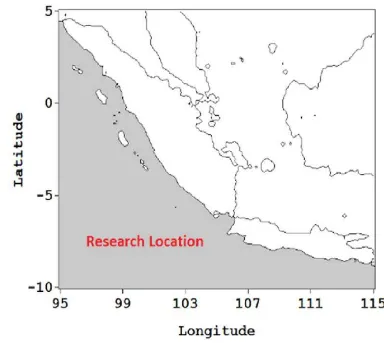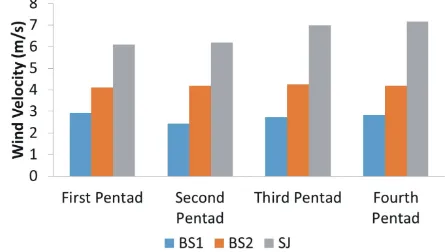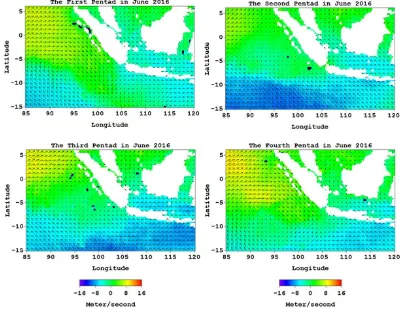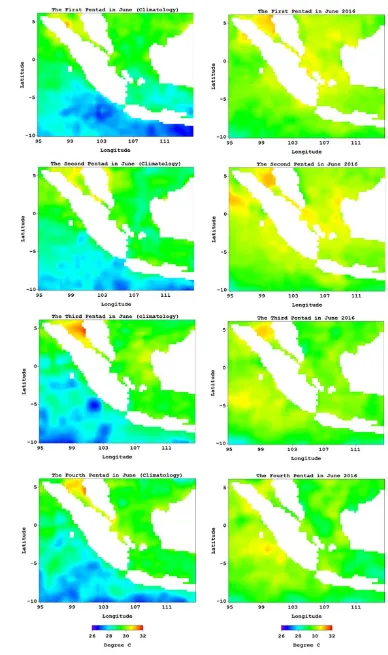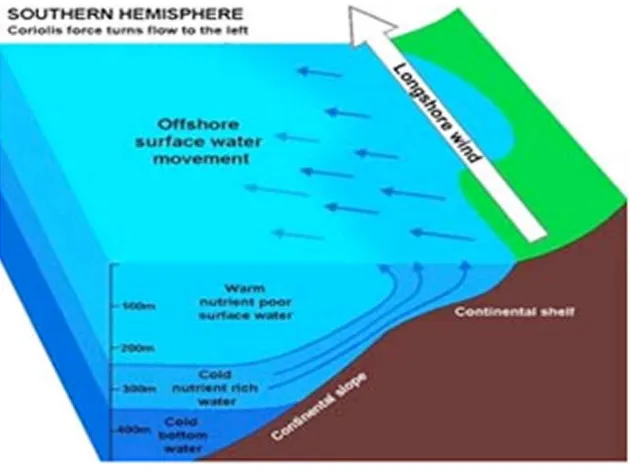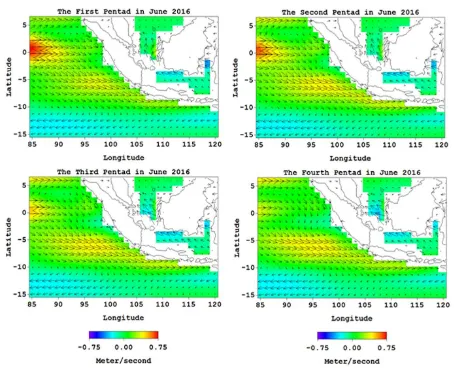© Author(s) 2017. CC BY-NC-ND Attribution 4.0 License.
Impacts of Extreme Weather on Sea Surface Temperature in the
Western Waters of Sumatera and the South of Java in June 2016
Martono
Centre of Atmospheric Science and Technology (LAPAN) Jl. Dr. Djundjunan 133 Bandung, West Java Corresponding author (e-mail: mar_lapan@yahoo.com)
Received: 13 January 2017 / Accepted: 05 February 2017 / Published: 01 July 2017
Abstract.Ocean dynamics are affected by the condition of the weather. Surface wind is one of the weather elements that has an important role on the ocean dynamics. This research was conducted to determine the impacts of extreme weather on sea surface temperature in the western waters of Sumatra and the southern waters of Java in June 2016. Data analysed in this study consisted of daily surface wind from 2007 to 2016, daily sea surface temperature from 1987 to 2016, and surface current from 1994 to 2016. The method used in this research was anomaly analysis. The result showed that in June 2016, extreme weather occurred in those waters. The impacts of extreme weather in the western waters of Sumatra and the southern waters of Java caused lower upwelling intensity that was indicated by an increase of sea surface temperature. The Increases of sea surface temperature in the BS1, BS2, SJ were 0.9ºC, 1.8ºC, and 1.6ºC, respectively.
Keywords:Impacts, extreme weather, sea surface temperature, upwelling.
Abstrak.Dinamika laut dipengaruhi oleh kondisi cuaca. Angin permukaan merupakan salah satu unsur cuaca yang mempunyai peranan penting terhadap dinamika laut. Penelitian ini dilakukan untuk mengetahui dampak cuaca ekstrim terhadap suhu permukaan laut di perairan barat Sumatera dan selatan Jawa. Data yang digunakan terdiri dari angin harian dari 2007-2016, suhu permukaan laut harian dari 1987-2016 dan arus permukaan dari 1994-2016. Metode yang digunakan dalam penelitian ini adalah analisis anomali. Hasil penelitian menunjukkan bahwa selama bulan Juni 2016 telah terjadi kondisi cuaca ekstrim di perairan ini. Dampak cuaca ekstrim di perairan barat Sumatera dan selatan Jawa menyebabkan intensitas upwelling melemah yang ditandai dengan kenaikan suhu permukaan laut. Kenaikan suhu permukaan laut di BS1 mencapai 0,9ºC, di BS2 1,8ºC dan di SJ mencapai 1,6ºC.
Kata Kunci: dampak, cuaca ekstrem, suhu permukaan laut, upwelling.
1. Introduction
The dynamics of the marine environment are strongly influenced by the weather condition, hence, any change of the weather will affect the dynamics of the marine environment. Surface wind is the main factor of dynamics of marine waters. Energy transfer from surface wind to sea surface will generate surface current and wave (Dahuri et al., 1996; Ibrayev et al., 2010). Surface wind is also one element of climate control (Tjasyono, 2004).
Ocean dynamics of the western waters of Sumatra and the southern waters of Java are unique and complex since the waters
are affected by the monsoon system (Shenoi et al., 1999; Yoga et al., 2014). The monsoon system occurs due to the difference between the high air pressure and the low air pressure above the Asia and Australia continent. The monsoon system changes its direction once a year. One of the ocean events that occurs in the western waters of Sumatra and the southern waters of Java due to the monsoon system is upwelling events.
by several researchers among others Wyrtki (1961), Susanto, et al., (2001), Kunarso, et al., (2005), Kunarso, et al., (2011), Susanto and Marra (2005), Qu, et al., (2005), Kemili dan Putri (2012), and Syafik, et al., (2013). The most common method to determine upwelling events is by observing the data of sea surface temperature (Aldrian, 2008).
Extreme temperature and precipitation in Indonesia have been identified by Supari et al., (2016a) and in Borneo by Supari et al., (2016b). However, the investigation of the extent of such events to affect the potential of sea surface rise is important since there is an interaction between air temperature and sea surface as well as between precipitation and sea level (Martono, 2016; Supriatin & Martono, 2016). In the beginning of June 2016, extreme weather occurred in the western waters of Sumatra and
the southern waters of Java. The purpose of this study was to determine the impacts of extreme weather on sea surface temperature and sea surface rise in the western waters of Sumatra and the southern waters of Java in June 2016.
2. Research Method
The study area was the western waters of Sumatra and the southern waters of Java situated at 6° N - 10° S and 95° E - 114° E as shown in Figure 1. For the analysis purposes, the study area was divided into three parts: 1). BS1 which was the western waters of Sumatra from the middle part of the waters to the northern part; 2). BS2 which was the western waters of Sumatra from the middle part to the southern part; and 3). SJ which was the southern waters of Java.
Figure 1. The study area.
The data collected for the analysis consisted of daily surface wind from 2007 to 2016, daily
obtained from the Centre ERS d’Archivage et de Traitement - French Research Institute for Exploitation of the Sea; sea surface temperature data with 0.25° spatial resolution was obtained from the Physical Oceanography Distributed Active Archive Center NASA; sea level height anomaly data with 0.25° spatial resolution and
surface current data with 1° spatial resolution were obtained from the Ocean Surface Current Analysis Real-Time NOAA.
Method used in this research was anomaly analysis. The value of SST anomaly was calculated by the equation:
(1)
Where SSTA is the value of SST anomalies and is the climatological value of SST.
3. Results and Discussion
The climatological pattern of surface wind in the western waters of Sumatera and the southern waters of Java from the first to the fourth pentad in June is demonstrated in
Figure 2. Generally, there are two patterns of surface wind in the western waters of Sumatra during the specific time. In BS1, the surface wind blew to the northeast, meanwhile it blew to the north-west in BS2. The pattern of surface wind in SJ was the surface wind blew to the west.
Figure 3 shows the mean velocity of surface wind from the first to fourth pentad in the western waters of Sumatra and the southern waters of Java in June 2016. The mean velocity of surface wind in BS1 was higher than those of BS2 and the highest value was obtained by SJ. The values of mean velocity of
surface wind of BS1, BS2, and SJ were 4.2 m/s, 2.7 m/s, and 6.6 m/s, respectively. Intensity of surface wind velocity from the first until the fourth pentad in the western waters of Sumatra was almost similar, meanwhile, there was an increased velocity in the southern waters of Java.
Figure 3. Climatological mean surface wind velocity in June 2016.
Patterns of surface wind over the western waters of Sumatra and the southern waters of Java in June 2016 is shown in Figure 4. In June 2016, there was a change of surface wind pattern in these waters. In the first pentad in June 2016, surface wind over the western waters of Sumatra was between 5.5° S - 6° N that moved to the east with a mean velocity of 6.4 m/s. In the west coast of Sumatra, surface wind was parallel to the coast that moved to the south-east. Surface wind in the south-west waters of Sumatra formed a vortex which moved in a clockwise direction. The climatological pattern of surface wind in the southern waters of Java was almost similar, but the mean velocity was smaller which only reached 3.5 m/s.
The pattern of surface wind in the western waters of Sumatra changed in the
second pentad in June 2016. Meanwhile, the pattern in the southern waters of Java was the same with those in the first pentad. In the western waters of Sumatera situated at 1° S - 6° N and 85° E - 95°, the surface wind moved to the east with a mean velocity of 3.7 m/s. From the middle to the southern of the west coast of Sumatra, surface wind was parallel to the coast with a lower velocity than those in the first pentad. In contrast, the velocity of surface wind in the southern waters of Java increased which reached 7.8 m/s.
the west coast of Sumatra moved in parallel with the coast to the south-east. Meanwhile,
mean velocity of surface wind in the southern waters of Java was 7.5 m/s.
Figure 4. Mean velocity of surface wind in June 2016.
The pattern of surface wind in the fourth pentad in June 2016 was almost similar with the first pentad. In the western waters of Sumatra located between 5.5° S - 6° N, surface wind blew to the east with a mean velocity of 7.1 m/s. Surface wind in the west coast of Sumatra moved in parallel with the coast to the south-east. Mean velocity of surface wind over the southern waters of Java was 5.3 m/s.
The climatological pattern of sea surface temperature from the first to the fourth pentad and in the western waters of Sumatra and the southern waters of Java in June 2016, is illustrated in Figure 5. The climatological mean of sea surface temperature in the southern waters of Java in June was lower than those in the western
waters of Sumatra. Climatological means of sea surface temperature from the first to the fourth pentad in BS1, BS2, and SJ were approximately 29.3°C, 28.4°C, and 27.9°C, respectively.
The results indicated that the anomalies of sea surface temperature in the western waters of Sumatra and the southern waters of Java during the first to the fourth pentad of June 2016 showed a positive value. It was indicated by the relatively high sea surface temperature in June 2016. Normally, in June, the sea surface temperature in the southern waters of Java to the south-west waters of Sumatra is cold due to the upwelling process. The position of the Sun in the northern hemisphere leads to the low air pressure in the northern hemisphere and the high air pressure in the southern hemisphere. It causes the formation of the Australia monsoon. At the same time, the south-east trade wind blows in the western waters of Sumatra and the southern waters of Java. The Australia monsoon and the south-east trade wind have the same direction, so they have mutual reinforcement.
In June, surface wind in the southern waters of Java moves to the west. The stress of surface wind would push the surface water mass in the same direction with the wind to the west. Because it is located in the southern hemisphere, the movement of the water mass will be deflected to the left at a 45° angle to the wind direction and will form Ekman spiral. The net transport in the Ekman layer will be deflected to the left at a 90° angle to the wind direction. This condition will cause the surface water mass in the coastal waters to move towards offshore waters as shown in Figure 6. This mechanism caused sea level on the coast is lower than the offshore. In order to eliminate the sea level difference between the coast and the offshore, the water mass from the bottom layer will move to the surface. As a consequence, surface temperature in the coast is colder than the surrounding area.
Figure 6. Upwelling process in the southern waters of Java. Source: https://cmast.ncsu.edu
The analysis showed the anomaly of sea surface temperature in the western waters of Sumatera and the southern waters of Java increased from 1 – 20 June 2016. The rise of sea surface temperature was caused by the change of surface current due to extreme weather in those waters. In June, normally, the surface wind in BS1 moves to the northeast, in BS2 moves to the
Figure 7. The pattern of surface current in June, left (climatology) and right (2016).
Figure 8. Pattern of surface current from the first to the fourth pentad in June 2016.
Pattern of surface current in the western waters of Sumatera and the southern waters of Java from the first until the fourth pentad of June 2016 is demonstrated in Figure 8. In this period,
Current in the southern waters of Java shifted to the south up to 10°S. This mechanism caused surface current in the southern waters of Java from the coast of 10°S moved to the east. This pattern of surface current was contrast to the normal condition where the current moved to the west.
4. Conclusions
Based on the results, it can be concluded that extreme weather occurred in the western waters of Sumatra and the southern waters of Java in 1 – 20 June, 2016. Surface wind in the western waters of Sumatra moved to the south-east with higher intensity than the
normal condition. Extreme weather changed the pattern of surface current in the western waters of Sumatera that moved to the south-east as well as in the southern waters of Java that moved to the east. The change caused the lower upwelling intensity that led to the increase of sea surface temperature. The increases in BS1, BS2, and SJ were 0.9°C, 1.8°C, and 1.6°C, respectively.
5. Acknowledgements
Author would like to thank Center of Atmospheric Science and Technology for the financial support in this research.
6. References
Aldrian, E. (2008). Meteorologi Laut Indonesia. Badan Meteorologi dan Geofisika, Jakarta.
Dahuri, R., Rais, J., Ginting, S.P., Sitepu, M.J. (1996). Pengelolaan Sumber Daya Wilayah Pesisir dan Lautan Secara Terpadu. Pradnya Paramita, Jakarta.
Ibrayev, R.A., özsoy, E., Schrum, C., Sur, H.I. (2010). Seasonal variability of the Caspian Sea three-dimensional circulation, sea level and air-sea interaction. Ocean Sci, 6: 311–329.
Kemili, P., and Putri, M.R. (2012). Pengaruh Durasi dan Intensitas Upwelling Berdasarkan Anomali Suhu Permukaan Laut terhadap Variabilitas Produktivitas Primer Di Perairan Indonesia. Jurnal Ilmu dan Teknologi Kelautan Tropis, 4(1): 66-79.
Kunarso, Ningsih, N.S., Supangat, A. (2005). Karakteristik Upwelling di Sepanjang Perairan Selatan NTT Hingga Barat Sumatera. Ilmu Kelautan, 10 (1): 17 – 23.
Kunarso, Hadi, S., Ningsih, N.S., Baskoro, M.S. (2011). Variabilitas Suhu dan Klorofil-a di Daerah Upwelling pada Variasi Kejadian ENSO dan IOD di Perairan Selatan Jawa sampai Timor. Ilmu Kelautan, 16(3):171-180.
Martono, M. (2016). Seasonal and Inter Annual Variation of Sea Surface Temperature in the Indonesian Waters. Forum Geografi, 30(2), 120–129.
Qu, T., Du, Y., Strachan, J., Meyers, G., Slingo, J. (2005). Sea Surface Temperature and Its Variability in The Indonesian Region, Oceanography, 18(4): 50-61.
Supari, Tangang, F., Juneng, L., & Aldrian, E. (2016a). Observed changes in extreme temperature and precipitation over Indonesia. International Journal of Climatology, n/a-n/a. https:// doi.org/10.1002/joc.4829
Supari, Tangang, F., Juneng, L., Aldrian, E., Ibrahim, K., Badri, K. H., Yaacob, W. Z. W. (2016b). Spatio-temporal characteristics of temperature and precipitation extremes in Indonesian Borneo. AIP Conference Proceedings, 1784(1), 060050. https://doi.org/10.1063/1.4966888 Supriatin, L. S., & Martono, M. (2016). Impacts of Climate Change (El Nino, La Nina, and Sea
Level) on the Coastal Area of Cilacap Regency. Forum Geografi, 30(2), 106–111.
Susanto, D., and Marra, J. (2005). Effect of the 1997/98 El Niño on Chlorophyll a Variability along the Southern Coasts of Java and Sumatra, Oceanography, 18(4): 124-127.
Shenoi, S.S.C., Saji, P.K., Almeida, A.M. (1999). Near-surface circulation and kinetic energy in the tropical Indian Ocean derived from Lagrangian drifters. Journal of Marine Research, 57:885–907.
Syafik, A., Kunarso., Hariadi. (2013). Pengaruh Sebaran Dan Gesekan Angin Terhadap Sebaran Suhu Permukaan Laut Di Samudera Hindia (Wilayah Pengelolaan Perikanan Republik Indonesia 573). Jurnal Oseanografi, 2(3):318-328.
Tjasyono, B. (2004). Klimatologi. Penerbit ITB, Bandung.
Wyrtki, K. (1961). Physical Oceanography of the Southeast Asian Waters. Naga Report Volume 2, Scripps Institution of Oceanography, California.
